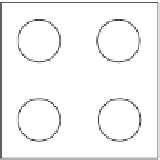Information Technology Reference
In-Depth Information
Polarization = 1
Binary value = 1
Polarization =
1
Binary value = 0
−
Figure
4.1.
QCA cell is constructed from four quantum dots arranged in a square
pattern. The two mobile electrons in the cell tend to repel each other and occupy
the diagonal sites of the cell. The electronic configuration of the cell is used to
encode binary information.
make a single cell, while others employ the cell in its entirety. Figure 4.2 illustrates
the numeric indexing normally used to refer to individual dots in a cell.
Using this indexing convention, cell polarization is defined as
ð
r
1
þ r
3
Þ r
2
þ r
4
ð
Þ
P
¼
;
r
1
þ r
2
þ r
3
þ r
4
where
r
i
is the charge density at dot i. The value of
r
i
represents the average
number of electrons occupying dot i [44]. In an isolated cell, the two ACTIVE
states will be energetically equivalent and, quantum mechanically, the state of this
isolated cell can form a superposition of the two diagonal states. In such a
superimposed state, the cell will have no net polarization. An unpolarized cell is
said to be in a ''NULL'' state and the influence of such a cell does break the energy
degeneracy in the neighboring cells; essentially the cell is said to be ''off''.
However, in a four-dot cell such superimposed states only exist if the cell is
maintained in coherent isolation; real devices will naturally drop to a random
ACTIVE state due to the loss of quantum mechanical coherence to the environ-
ment. Therefore, maintaining a stable NULL state in four-dot cells is a difficult
technical challenge. In order to overcome the challenges associated with coherent
NULL states, recent proposals have included two additional sites that introduce a
4
1
3
2
Figure
4.2.
Cell indexing used throughout this chapter.














Search WWH ::

Custom Search